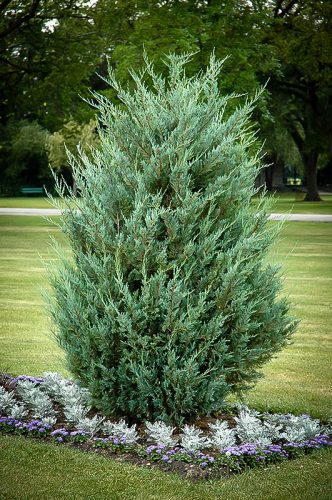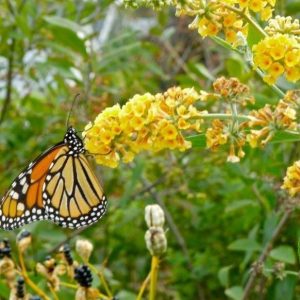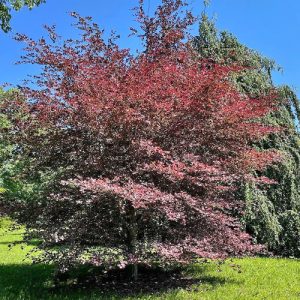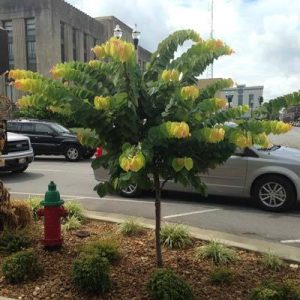Juniperus scopulorum is a remarkable pyramidal shaped tree better known as the Rocky Mountain Juniper. This slow growing evergreen maintains a slender width while growing to a moderate height. This useful combination makes it an ideal selection for locations in your landscape project that require a visual height element but may not have the width to accommodate a wider tree or shrub. The Moonglow variety of juniper is also an ideal choice for horticulturists interested in creating bonsai. The upward forming branches produce needle shaped foliage in a deep blue-green color with a delicate silvery tinge, and these maintain their color throughout the entire year. Its hardiness also means that it is suitable for locations that may experience drought conditions, adding to its versatility. If you are in need of a slender and beautiful evergreen plant that can adapt to nearly any design feature, the Rocky Mountain Juniper is the tree for you.
Trees have a spectacular, wild appearance that always makes people think of forests or mountainsides. For the gardener, however, they’re very versatile; they can have their own special place in your urban landscape and, sometimes, even in your own home. The Moonglow Rocky Mountain Juniper is one tree that can meet a variety of needs as well as adapt appropriately to numerous climate and soil conditions.
Not only does it make an attractive and beneficial environmental addition to your property, but this particular juniper is a popular choice for use in the art of bonsai. Bonsai is the creations of stunning miniatures of full-sized trees placed in decorative pots, and the results are often used in home décor. Horticulturists choose the Rocky Mountain Juniper because of its exceptional beauty that cannot be bested by other trees of similar shape and color.
Growing Moonglow Rocky Mountain Juniper Trees
The Rocky Mountain Juniper is native to North America and can be found throughout the country, as well as further north into Canada. As mentioned, it is regularly used in bonsai but also makes a perfect specimen for buffering noise around parking lots or from busy roads near your home. They are regularly used in the United States in the median strip between our highways. Its pyramidal shape is symmetric and uniform from the base of the truck all the way to the top. In home or commercial landscape use the juniper can reach a moderate height of about 15 feet with a six foot spread. If left to its own device to grow as it would in nature, it can top 30-40 feet with a ten to 15 foot spread.
Appearance
The blue-green needles form along the branches to create a full and dense display that lasts throughout the entire year. Unlike other needle-foliaged trees, the Rocky Mountain Juniper retains most of its needles, ensuring an unlittered base and surrounding area. The branches on the juniper form at the base and slope upwards as the tree matures, giving it a full and perky appearance. It is very similar in appearance to the Eastern Red Cedar and it may hybridize with it if there are examples grown close by. This is a non-flowering specimen that does not produce any cones or fruits. However, its thick foliage is a favorite refuge for many types of birds, as well as small animals like squirrels and chipmunks.
Hardiness
Since the Rocky Mountain Juniper is so adaptable and versatile, it is suitable for a wide range of USDA plant hardiness zones. It is suitable for zones 3 through 7, which includes the lower parts of Alaska and Minnesota, into the warmer locations of northern Georgia and Virginia. In colder locations that are subject to a lot of rain (which can result in ice) the juniper will need a little bit of extra attention. Ice covering that lasts more than a day or two can damage the plants fragile foliage.
Soil Conditions and Drought Tolerance
Junipers do well in soil that is loamy, acidic and alkaline based. It has a very high drought tolerance but it is still important to remember that the tree will need to be watered regularly. Droughts can cause the root system to dry out completely and result in the tree perishing. Soil should be able to drain adequately to prevent damage to the roots from over watering.
Sun Exposure
Rocky Mountain Junipers also love the sun so you will want to ensure that the location you choose to plant your trees can receive as much of the daytime sun as possible. Some shade is acceptable but too much can be detrimental to the health of your tree. Overall, the juniper is going to be quite happy in most locations if you are mindful of its minimal list of intolerances. The tree’s ability to adapt fairly well to its environment can also reduce the amount of time you will need to care for it.
Pests and Diseases
The Rocky Mountain Juniper may attract bagworm caterpillars and juniper webworms. Both insects can cause damage to branches and the foliage. However if you check your tree periodically you can remove affected branches and prevent a sever infestation. The juniper is also susceptible to twig blight, which may cause death to the tree twig tips. Pruning out the dead bits will encourage new replacement growth. There are also three types of tree rust that may affect the juniper; cedar-apple, hawthorn and quince rust. Pruning away the diseased branches in the spring will again prevent further damage.









